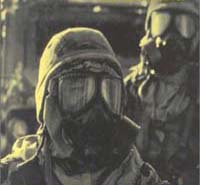Body Horror is Back (Because it Never Left)
By way of fortification against epidemics and bioterrorism, the bodies of populations are entrusted to bioinformatic administration. The horror of malformity and the perfectionist fascination with health provide the pretext for biological control, surveillance and management of the body. In this context, does it matter if the 'rage virus' epidemic portrayed in the film 28 Days Later is scientifically inaccurate? Eugene Thacker draws attention to contemporary mutations in the concept and practice of security. Estranged Bodies
When the film 28 Days Later was released this past summer in the US, it had its fair share of summer movie competition. The film, which did not fare well in the UK, was somewhat more successful in the US, though, by pure dollars, it paled in comparison to heavy-hitters such as Matrix Reloaded and Terminator 3. While receiving some critical acclaim, it seemed to be caught between genre horror (a remix of the zombie flick) and art film (akin to Ringu or The Eye).
However, one review of 28 Days Later is worth mentioning, if only because of the relationships it sets up between science and science fiction. In a New York Times article, Harold Varmus wrote about 28 Days Later from the perspective of a microbiologist. Varmus, a former head of the National Institute of Health and current president of the Memorial Sloan-Kettering Cancer Center, is widely recognised for his research into the mechanisms of cancerous cells.
In Varmus’ short, informal article, a good deal of space is utilised making two points: that the ‘rage virus’ in 28 Days Later is not scientifically accurate, and that, even if we accept it as metaphor, the rage virus is not scientifically accurate. In short, Varmus chooses to make very little of the film, except to note that the epidemic portrayed in 28 Days Later is a far cry from the recent experiences of AIDS, SARS, and other emerging infectious diseases.
First, the obvious reply: of course it’s not scientifically accurate, it’s science fiction, remember? But now a not-so-obvious reply: 28 Days Later is in many ways a very accurate social and political representation of what it may mean to live in an age when globalisation is isomorphic with epidemiology.
The point here is not to defend 28 Days Later – in many other ways it is a deeply conflicted movie. But consider the genres (or sub-genres) the film brings together. First there is the zombie film, a tradition that is indelibly marked by George Romero’s Night of the Living Dead. It is hard not to see a reference to the critique of racism in Romero’s film in the chained black male soldier at the military base. Then there is the sub-genre of the medical thriller, made popular by authors such as Robin Cook and Richard Preston, as well as films such as The Andromeda Strain and Outbreak. These stories usually follow a relatively stock path: a dangerous new virus is accidentally released or uncovered and the heroic team of ‘virus hunters’ must solve the mystery of the viruses’ origin (epidemiology-as-detective story).
To these two components – the zombie film and the medical thriller – 28 Days Later adds elements from the ‘last man’ or post-apocalyptic scenario (Mary Shelley’s under-appreciated novel The Last Man establishes many of the common themes), as well as from the ‘revenge of nature’ scenario. In the Cold War era it used to be giant animals – ants, wasps, worms, spiders, even rabbits, but now, apparently, it’s micro-organisms, viruses, even DNA itself (Resident Evil, Species, The Thing). Put it all together and you have the ingredients for a film which meditates on the future and fate of the body politic. That body politic is not just anatomical (as it is in Hobbes), and not even immunological (as it is in the doctrines of eugenics and racial purity); the body politic in 28 Days Later is decidedly genetic, or better, it is a ‘molecular’ body politic.
 > Still from the film 28 Days Later, directed by Danny Boyle.
> Still from the film 28 Days Later, directed by Danny Boyle.
This is demonstrated in the film by its successive settings. First, the entire event of the rage virus takes place on an island, but an island with a long, fraught history of colonial expansion and imperial rule. ‘Island fever’ doesn’t explain why the UK gets the rage virus. Instead, the film moves steadily from one institutional site to another: from hospital (where James, the main character, awakes), to the church (where all pastors are infected), to the home (both the homes of James and of various tenements), to the military base (located in Engels’ industrial Manchester), and finally to the pastoral countryside. At each stop, the ‘last man’ encounters the ‘revenge of nature’, which manifests itself in the rabid, cannibalistic infected – a thronging mass of bodies which do nothing except move towards.
If 28 Days Later stopped at this point, it would indeed be yet another re-writing of the zombie film, minus the campy humour of films like Army of Darkness or the revelatory abjectness of Cannibal. But the film has a number of highly ambivalent, uncomfortable scenes in it. For instance, the entire episode at the military base (or it is a castle?) throws us into a kind of right-wing commune, bent on both the defence of the population and the insurance of its survival and reproduction (the motif/fantasy of any ‘last man’ scenario is the question of how to re-populate the world). As the military commander in the film shows, the ‘state of nature’ demands two things: an apparatus for security, and a set of institutions for the production and reproduction of social order.
To put it bluntly, 28 Days Later poses two problems simultaneously: the problem of a threat to social order and cohesion (virus or weapon, natural or artificial), and alongside it, the problem of that social order and supposed cohesion itself. The answer the film provides is ambivalent: you can only establish an alternative social order by ‘becoming-infected’ and utilising that to break down the last remnants of social order from within, in effect playing one off of the other.
Now, taken literally this is laughable. Taken metaphorically, it gets us no further than the critiques of marginalisation and normativity. How else to take this?
Biological Security
Perhaps in terms of tactics and strategies. In particular, it is interesting to note how the concept of ‘security’ has been deployed recently to denote a wide range of politicised activities, from government-military defence (the US military’s ‘Operation Bioshield’) to public campaigns which foster an air of civilian defence (the ‘Are You Prepared?’ website).
At the most basic level, the concept of security, and in particular national security, implies the existence of a threat or threats which undermine social order and hence the security of the population. In this sense, security is synonymous with the state-form, or with the state’s ability to legitimise a range of practices (from deterrence strategies to the testing of next-generation weapons), in which the living mass of bodies known as the population comes under state control – as a biological entity.
This biological security is both a concept and a set of practices. A recent RAND report, The Global Threat of New and Re-emerging Infectious Diseases, fosters a notion of ‘human security’ which is both related to but distinct from conventional notions of national security. As the authors state, ‘traditional spatial notions of security, of national stability defined purely in terms of territorial sovereignty and integrity – which is reflected on a larger scale by the containment policies of the Cold War – simply do not work in today’s more complex geostrategic environment’ (p. 3).
Security, once understood as the defence, regulation, and fortification of national boundaries, is now confronted with globalised networks of all kinds: ‘A common thread running through many of the threats currently facing the global community – including the spread of disease, the drug trade, environmental degradation, and terrorism – is their transnational character’ (p. 2).
But the shift which the RAND report fosters – from national security to human security – too easily mirrors the call for an international human rights, and the concept of ‘right’ is distinct from the concept of ‘security’. As the RAND report notes, human security is differentiated from national security by its emphasis on the individual rather than on the state, presumably because processes of globalisation render national identity more fragile than the identity of an ideal ‘global citizen’. But the conflicts of globalisation often give rise to any number of fundamentalisms, and nationalism is far from being rendered irrelevant in our current context.
Indeed, the concept of human security is paradoxical. If a human security is in fact an international security, then it is no more than traditional national security writ large, a kind of globalisation of security: ‘whereas traditional security regards states as competitors whose interactions will always be of a zero-sum nature…human security stresses the potential for individual/communitarian cooperation that is undertaken to achieve absolute gains that will be to the benefit of all’ (p. 7).
While the intentions behind this expansion into human security are promising, the expansion of security – in effect, a security without borders – begs the question: what is the threat? Who is not secure in this global security? While there would be no desire to return to the ‘zero-sum’ game of traditional security, can one so easily detach the concept of security from its political and militaristic roots?
Such questions can be seen in a different light when we consider recent events surrounding SARS and other emerging infectious diseases. SARS, like all emerging infectious diseases (as category developed by the World Health Organisation), is a disease that operates through and is a product of, the networks of globalisation. SARS utilised, or rather exploited, three different kinds of networks and layered them on top of each other. The transportation network of planes, airports, and hotels (the first cases from Guangdong province in China were transported by a physician to his hotel, and then by plane to Canada), the communications network of website and TV updates (WHO officials used a common database to share patient data), and finally the biological network of infection and transmission (the SARS virus mutated and jumped from animals to humans).
In such instances, it is plainly apparent that the notion of security needs to be rethought. The responses to SARS varied – from simply shutting down networks (air travel restrictions, quarantine), to the sharing of essential information (uploading of patient data to a shared database).
At some point, the expansion of the concept of security moves away from politico-militaristic terms and moves into existential territory. At some point, the only threat that is ‘outside’ human security is biology itself, natural or human-made. The immanence of security, taken to its logical extreme, means a biological security against disease, accident, and death. This is, in fact, a biological security against biology itself.
 > Still from 28 Days Later.
> Still from 28 Days Later.
But it is precisely the notion of ‘biology itself’ or rather ‘life itself’ which is continually being reconfigured, rearticulated, and contested in a number of domains. As Michel Foucault notes, this is a concern over the 'political problem of the population', which 'is not conceived as a collection of legal subjects, nor as a mass of human arms intended for labour; it is analysed as a set of elements that, first, is connected with the general system of living beings' (p. 70). Biotechnology is a key factor here, because, as a hegemonic scientific domain, biotech plays a central role in reconfiguring how we think about life, and this is manifested in everything from science research to science fiction film.
Biology is thus foundational for national as well as human security; it is that which remains unmentioned in the discourse surrounding security. If traditional national security was concerned with the state or the population, and if the neo-liberal human security is concerned with the global individual, then the thread that ties them together is a political and militaristic attitude towards biology. Not the state, not the population, and not the individual – but simply the integrity of living biomass.
What, then, is biological security? It is the assumption that biological life or ‘life itself’ is something which needs to be defended, and it needs to be defended because it is productive and constitutive of social and political coherence. Such a biological security requires a range of techniques for both regulating this global body politic or this living biomass. Along with biotechnologies such as genomics and genetic engineering, information technologies (databases, simulation, modelling) also play a key role in articulating living biomass.
But more than that, biotechnology also promotes itself in the role of optimising the body politic and fortifying it for immanent biological threats. We see this happening in several areas already in the US: advanced immunisations against biological agents for soldiers, research into biowarfare deterrence and defence, telemedicine and telesurgery on the battlefield, and a public outreach campaign which stresses, in Cold War rhetoric, the need to be informed and prepared for a biological threat.
Body Horror
We have commented on some aspects of emerging infectious diseases, bioterrorism, and the concept of biological security, but we have not yet commented on the phrase ‘body horror’ which describes all these. ‘Body horror’ is usually found in studies of horror film and the horror genre generally. It is thus primarily a cultural term, and it describes cultural forms which often express a conflicted anxiety over the body, and the variable meanings which cultures ascribe to bodies.
But body horror is not just about slasher movies, splatter horror, or monstrous metamorphoses; it is also pervasive in cultures which display an obsession over fitness crazes, extreme diets, fashion, cosmetic surgery, and pharmaceuticals.
In the context of biotechnologies, body horror has several components: first is the general estrangement from the body, the point at which the body becomes ‘other’. This is not only a scenario from science fiction films such as The Thing or Alien. This can also be expressed in the truism that ‘the body has its own logic’. Healing, or the body’s capacity to heal, can be as much a source of body horror as disease. This is, in many ways, at the source of the continued efforts to develop viable, long-term cancer therapies. The revelation that cancer is not an anomaly, but rather the body functioning super-normally, has frustrated our common notions of the normal and the pathological.
 > Still from 28 Days Later.
> Still from 28 Days Later.
A second aspect of body horror, is that it arises form a boundary-confusion. Body horror may originate from without, but more often than not it manifests itself from within. Viruses and autoimmune disorders are key examples, and again we see this magnified and exaggerated in films such as Shivers and Virus. Thus the ‘horror’ aspect of body horror derives from a loss of biological control, or, put differently, the exploit of holes in biological security.
Finally, body horror is above all an affective concept; it describes a certain fascination and abjection with morphology, or the change of biological form. In the age of biotech and infotech, this fascination-abjection comes in the form of genetic mutations. In this constant interplay between genotype and phenotype, between implicit and explicit, we see the ongoing debates over the genetic foundations of disease, race, and even behaviour. In such instances, information – especially genetic information - becomes a highly contested entity, as witnessed in films such as The Fly (yes, the Cronenberg version). In body horror, information turns into deformation and transformation.
Thus body horror raises the issues of the estrangement of the body, its boundary-confusion, and its preoccupation with morphogenesis. In relation to biotechnologies and the discourses surrounding ‘security’, body horror is primarily about biological control – both our understanding of the inner workings of molecular biology, and our understanding of the inner workings of politics in an international arena.
Weaponising the Body
If body horror has returned with a new face (one that is genetic-informatic), then how does this affect the ways in which biology is related to security, war, and militarism? One answer is that the biological body becomes increasingly fragmented and distributed through advances in technology, eventually giving way to the pure mobility of information.
Paul Virilio refers to three innovations in the body’s ability to achieve this escape velocity: the transportation revolution of the railroad (where the whole body of the subject is rendered a mobile), the transmission revolution of communications (where the body projects itself or its voice across distance), and now, the transplantation revolution (where the actual parts of the body are extracted, circulated, re-implanted).
In his characteristic doomsday tone, Virilio warns of the indeterminacy which derives from this third, genetic-medical revolution. Just as each technology provides the conditions for its own accidents (the train creates the derailment, and so on), so do biotechnologies, for Virilio, create the conditions for the ‘genetic bomb’, or a biological catastrophe.
But Virilio does not consider the implications of this synergy of biotech, infotech, and the military-industrial complex. In the context of biowarfare and bioterrorism, ‘weaponising the body’ means the complete absence of any industrial, mechanical, or even information technologies. The very notion of biological warfare implies this – that biology itself, ‘life itself’ can become both a technology, and therefore a weapon. The most harrowing scenario is the combination of a weaponised virus and suicide bomber – the literal weaponising of the body.
 > Detail from the cover image of Biotechnology, Weapons, and Humanity, BMA (1999).-------------------------------------------------------------------------------------------------Such scenarios are mentioned in a number of publications on biological warfare. For instance, a 1999 BMA (British Medical Association) report on Biotechnology, Weapons, and Humanity, warns against a hypothetical scenario in which an actual genetic bomb could target specific populations using biological agents which act on genetic polymorphisms or genetic differences between ethnic populations. While the BMA report ultimately comes down on genetic weapons as more fiction that fact, it does explicitly note the possibility of utilising the tools and techniques of biotechnology for harmful ends. In such a case, the ongoing debate over the relation between genetics, population, and race is key, as it provides the potential scientific justification for an increased biological security.
> Detail from the cover image of Biotechnology, Weapons, and Humanity, BMA (1999).-------------------------------------------------------------------------------------------------Such scenarios are mentioned in a number of publications on biological warfare. For instance, a 1999 BMA (British Medical Association) report on Biotechnology, Weapons, and Humanity, warns against a hypothetical scenario in which an actual genetic bomb could target specific populations using biological agents which act on genetic polymorphisms or genetic differences between ethnic populations. While the BMA report ultimately comes down on genetic weapons as more fiction that fact, it does explicitly note the possibility of utilising the tools and techniques of biotechnology for harmful ends. In such a case, the ongoing debate over the relation between genetics, population, and race is key, as it provides the potential scientific justification for an increased biological security.
But we might ask: does a genetic bomb need to really be a bomb? Could it not be a letter (a message)? While reports such as the BMA are concerned with the potential for actual genetic bombs being developed, we might wonder whether we have already seen the first traces of the genetic bomb in the recent Anthrax attacks in the US. While the 2001 Anthrax attacks resulted in a minimal success biologically speaking, they were highly successful on a social, cultural, and political level. They dominated every news headline, fostering a sense of body horror in the purchases of gas masks and Cipro. This leads us to question the nature of the biological weapons of the future. The genetic bomb might not be an explosion, but rather an infiltration, a perturbation in the networks of command and control, which result in a general sense of political instability.
But rather than looking for an example of an actual genetic bomb (which still denotes a Cold War mentality towards the technology of warfare), we might end by mentioning several other areas in which this intersection of biotech, infotech, and militarism intersect.
One such area is civilian bio-defence. The combination of mass media reportage (SARS on the cover of Time and Newsweek), along with more informational resources such as the WHO’s (World Health Organisation) ‘Global Outbreak Alert and Response Network’, and documentaries such as Avoiding Armageddon (PBS), all contribute to a discourse which fosters a Cold War ambiance of being informed, prepared, and ready. The only problem is that, as we’ve been told over and over, we are fighting a new kind of enemy, and the basement bunker is not a defence against the everydayness of the postal system, public transit, or even the salad bar – all which have been sites of past bioterrorist attacks.
Another area is video games. The ‘military-entertainment complex’ may soon become the ‘military-biotech-entertainment complex’ or some such cumbersome phrase. There is a long tradition of simulation technologies used for training pilots and soldiers (and subsequently re-packaged as video games). Might the same be said for biotech? What would be the equivalent of military simulation for biowarfare?
The true biotech games do not yet exist, but they are around the corner. Imagine a combination of the militarism of Half-Life or Resident Evil, with the strategising of Civilisation or SimCity. This would be a game in which you, a virus hunter employed by the special ops, must track down and successfully deter a biological agent released by a terrorist organisation. The key to winning this game is not shooting skills, but a strategic command of the territory, the population, and the multiple networks which constitute the city. You would have access to medical and hospital records, demographic databases, circulation of biological materials, individual patient profiles – control, surveillance, management. ‘SimSARS’?
References
‘Are You Prepared?’ website: http://areyouprepared.com
Boss, Pete. ‘Vile Bodies and Bad Medicine’, Screen 27.1 (January-February 1986).
British Medical Association (BMA). Biotechnology, Weapons, and Humanity. Amsterdam: Harwood, 1999.
Brower, Jennifer, and Peter Chalk. The Global Threat of New and Re-emerging Infectious Diseases. Santa Monica: RAND, 2003.
Foucault, Michel. ‘Security, Territory, and Population’. Ethics: The Collected Works of Michel Foucault. New York: The New Press, 1994.
Varmus, Harold. ‘Virus as Metaphor: Microbiology and 28 Days Later’. New York Times (6 July 2003).
Virilio, Paul, and Sylvere Lotringer. Crepuscular Dawn. New York: Semiotext(e), 2002.
Williams, Linda. ‘A Virus is Only Doing its Job’. Sight & Sound (May 1993).
-
If you liked this article, you may be interested in Andrew Goffey's Mens sana in corpore sano - or keep taking the tablets, which appeared in Mute 24 (May 2002)
Mute Books Orders
For Mute Books distribution contact Anagram Books
contact@anagrambooks.com
For online purchases visit anagrambooks.com






